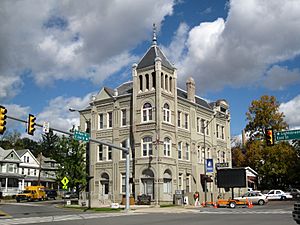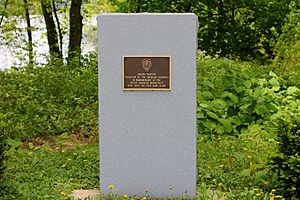Bloomsburg, Pennsylvania facts for kids
Quick facts for kids
Bloomsburg, Pennsylvania
|
|
|---|---|

Bloomsburg Town Hall in 2012
|
|
| Nicknames:
The only incorporated town in Pennsylvania, Bloom, Town of Love
|
|

Location of Bloomsburg in Columbia County, Pennsylvania
|
|
| Country | United States |
| State | Pennsylvania |
| County | Columbia |
| Bloom Township | 1797 |
| Town of Bloomsburg | March 4, 1870 |
| Area | |
| • Total | 4.69 sq mi (12.14 km2) |
| • Land | 4.35 sq mi (11.26 km2) |
| • Water | 0.34 sq mi (0.88 km2) 7.22% |
| Elevation | 531 ft (162 m) |
| Population
(2020)
|
|
| • Total | 12,711 |
| • Density | 2,923.41/sq mi (1,128.81/km2) |
| Time zone | UTC-5 (EST) |
| • Summer (DST) | UTC-4 (EDT) |
| ZIP Code |
17815
|
| Area codes | 570 and 272 |
| FIPS code | 42-07128 |
Bloomsburg is a cool town in Pennsylvania, United States. It's the main town in Columbia County. Located in northeastern Pennsylvania, it sits about 40 miles southwest of Wilkes-Barre right by the Susquehanna River.
Guess what? Bloomsburg is the only place in Pennsylvania officially called a "town"! Most other places are cities, boroughs, or townships. In 2020, about 12,711 people lived here. Bloomsburg is also part of a larger area called the Bloomsburg-Berwick Metropolitan Statistical Area.
Contents
Discover Bloomsburg's Past
The first European settlers arrived in Bloomsburg around 1772. A man named James McClure built a log cabin here. For a long time, it was just a small village known as Bloom Township.
Bloomsburg officially became a town on March 4, 1870. This is why it's special! Even if other places call themselves "towns," Bloomsburg is the only one legally recognized as an "incorporated town" in Pennsylvania.
The town has some cool historic spots. The Bloomsburg Historic District and the Rupert Covered Bridge No. 56 are listed on the National Register of Historic Places.
Where is Bloomsburg Located?
Bloomsburg is in the western part of Columbia County. It's on the north side of the Susquehanna River and next to Fishing Creek. The southern part of town is flat, right by the river. The northern part has a hill called Turkey Hill, which is about 940 feet high. Bloomsburg University of Pennsylvania is located on this hill.
The town covers about 4.69 square miles. Most of this is land, but about 7.22% is water, mostly from the rivers and creeks.
Nearby Towns and Townships
Bloomsburg is surrounded by several other communities:
- Mount Pleasant Township (to the north)
- Scott Township (to the east)
- Catawissa Township (to the south, across the Susquehanna River)
- Montour Township (to the southwest)
- Hemlock Township (to the west)
Bloomsburg's Weather
Bloomsburg has different weather throughout the year. In January, the average high temperature is 35°F, and the average low is 19°F. In July, it gets warmer, with an average high of 85°F and a low of 62°F. February usually has the least rain, while June gets the most.
Who Lives in Bloomsburg?
| Historical population | |||
|---|---|---|---|
| Census | Pop. | %± | |
| 1820 | 1,626 | — | |
| 1830 | 2,090 | 28.5% | |
| 1840 | 1,774 | −15.1% | |
| 1850 | 3,122 | 76.0% | |
| 1860 | 2,668 | −14.5% | |
| 1870 | 3,341 | 25.2% | |
| 1880 | 3,702 | 10.8% | |
| 1890 | 4,635 | 25.2% | |
| 1900 | 6,170 | 33.1% | |
| 1910 | 7,413 | 20.1% | |
| 1920 | 7,819 | 5.5% | |
| 1930 | 9,093 | 16.3% | |
| 1940 | 9,799 | 7.8% | |
| 1950 | 10,633 | 8.5% | |
| 1960 | 10,655 | 0.2% | |
| 1970 | 11,652 | 9.4% | |
| 1980 | 11,717 | 0.6% | |
| 1990 | 12,439 | 6.2% | |
| 2000 | 12,375 | −0.5% | |
| 2010 | 14,855 | 20.0% | |
| 2020 | 12,711 | −14.4% | |
| Sources: | |||
In 2010, there were 14,855 people living in Bloomsburg. Most residents (89.6%) were White. About 6.2% were African American, and 1.6% were Asian. About 3.4% of the population was Hispanic or Latino.
The median age in Bloomsburg in 2000 was 22 years old. This means half the people were younger than 22, and half were older. Many young people live here because of the university.
Learning in Bloomsburg
Bloomsburg has great schools for students of all ages.
Local School Districts
- The Bloomsburg Area School District serves about 1,800 students from the town and nearby areas.
- The Central Columbia School District serves about 2,100 students in the eastern and northern suburbs.
Vocational and Higher Education
- The Columbia-Montour Area Vocational-Technical School in Bloomsburg offers many trade programs for high school students.
- Bloomsburg University of Pennsylvania is a large university with over 10,000 students. It's one of the 14 schools in the Pennsylvania State System of Higher Education.
There are also several private schools in and around Bloomsburg.
Fun Things to Do
Bloomsburg offers places to relax and have fun!
Parks and Recreation
- The Town Park is a large park, about 43 acres in size, created in 1927.
- Next to the park, you'll find the Norris E. Rock Memorial Swimming Pool and the Bloomsburg Skate Park.
- The town is also developing a new area with athletic fields, a nature preserve, and walking paths near Fishing Creek and the Susquehanna River. These paths will connect to the Columbia-Montour Rails-to-Trails program.
Cultural Attractions
- The Bloomsburg Theatre Ensemble is a professional theater group that puts on shows and educational programs.
- The Bloomsburg Public Library has been serving the community since 1899.
- The Bloomsburg Fair is a huge event! It's the largest agricultural fair in Pennsylvania and has been happening since 1855.
- The David Stroup Fountain is a beautiful landmark in Market Square. It was first built in 1892 and was restored in 1982.
- The Children's Museum is a fun place for kids to explore and learn.
Local News and Media
Bloomsburg has its own daily newspaper, the Press Enterprise. There are also online news sites like The Bloomsburg News and BloomUtoday.com. Bloomsburg University has its own student newspaper, The Voice, and an online news site called BUnow.
You can also listen to several radio stations in the area, including WHLM, WMMZ, and WCFT-FM.
Getting Around Bloomsburg
Bloomsburg has its own small airport, the Bloomsburg Municipal Airport, located by the Susquehanna River.
Major roads in Bloomsburg include U.S. Route 11, Pennsylvania Route 42, and Pennsylvania Route 487. Interstate 80 passes north of the town, making it easy to travel to other cities like Wilkes-Barre and Williamsport. The state capital, Harrisburg, is about 80 miles south.
Famous People from Bloomsburg
Many interesting people have connections to Bloomsburg, including:
- Lacy J. Dalton, a country music singer.
- Doug Davis, a former baseball player for the Texas Rangers.
- Paul Hartzell, another baseball player.
- Sean Panikkar, an opera singer.
- Krysten Ritter, a well-known actress.
- Benny Montgomery, a baseball player.
- Jared Verse, a football player.
See also
 In Spanish: Bloomsburg (Pensilvania) para niños
In Spanish: Bloomsburg (Pensilvania) para niños







